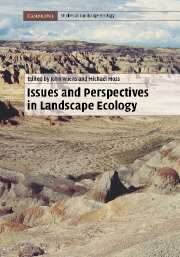Book contents
- Frontmatter
- Contents
- List of contributors
- Preface
- PART I Introductory perspectives
- PART II Theory, experiments, and models in landscape ecology
- 3 Theory in landscape ecology
- 4 Hierarchy theory and the landscape … level? or, Words do matter
- 5 Equilibrium versus non-equilibrium landscapes
- 6 Disturbances and landscapes: the little things count
- 7 Scale and an organism-centric focus for studying interspecific interactions in landscapes
- 8 The role of experiments in landscape ecology
- 9 Spatial modeling in landscape ecology
- 10 The promise of landscape modeling: successes, failures, and evolution
- PART III Landscape patterns
- PART IV Landscape dynamics on multiple scales
- PART V Applications of landscape ecology
- PART VI Cultural perspectives and landscape planning
- PART VII Retrospect and prospect
- Index
- Plate section
- References
7 - Scale and an organism-centric focus for studying interspecific interactions in landscapes
from PART II - Theory, experiments, and models in landscape ecology
Published online by Cambridge University Press: 20 November 2009
- Frontmatter
- Contents
- List of contributors
- Preface
- PART I Introductory perspectives
- PART II Theory, experiments, and models in landscape ecology
- 3 Theory in landscape ecology
- 4 Hierarchy theory and the landscape … level? or, Words do matter
- 5 Equilibrium versus non-equilibrium landscapes
- 6 Disturbances and landscapes: the little things count
- 7 Scale and an organism-centric focus for studying interspecific interactions in landscapes
- 8 The role of experiments in landscape ecology
- 9 Spatial modeling in landscape ecology
- 10 The promise of landscape modeling: successes, failures, and evolution
- PART III Landscape patterns
- PART IV Landscape dynamics on multiple scales
- PART V Applications of landscape ecology
- PART VI Cultural perspectives and landscape planning
- PART VII Retrospect and prospect
- Index
- Plate section
- References
Summary
Ecologists arguably have been remiss in not developing a formal underpinning for the epistemology of ecology, at least not until the 1980s. At that time, the rather forced imposition of deterministic or heavily constrained stochastic population and community models (see Roughgarden, 1979) drew fire, principally through the emergence of ideas of system “openness” (Wiens, 1984; Gaines and Roughgarden, 1985; Amarasekare, 2000; Hughes et al., 2000; Thrush et al., 2000), non-equilibria (DeAngelis and Waterhouse, 1987; Seastadt and Knapp, 1993) and, especially, “scale” (Wiens et al., 1987; Kotliar and Wiens, 1990; Holling, 1992; Levin, 1992, 2000; Pascual and Levin, 1999). Scales of measurement and observation have tremendous impact on the interpretation of what we think we know about systems and how they operate, which clearly has ramifications for most of the hotly contested areas in community ecology. One such dispute concerns the respective roles of “top-down” (large-scale patterns determine the possibilities for small-scale ones; Whittaker et al., 2001) and “bottom-up” (large-scales are emergent properties of small-scale processes; Wootton, 2001; Ludwig, this volume, Chapter 6) processes in pattern generation in ecological communities (Carpenter et al., 1985).
An increasing number of field studies (e.g., Bowers and Dooley, 1999; Orrock et al., 2000) and simulations (e.g., Bevers and Flather, 1999; Mac Nally, 2000b, 2001) conducted at multiple spatial scales show that outcomes depend upon how the study is constructed and conducted.
- Type
- Chapter
- Information
- Issues and Perspectives in Landscape Ecology , pp. 52 - 69Publisher: Cambridge University PressPrint publication year: 2005
References
- 6
- Cited by



